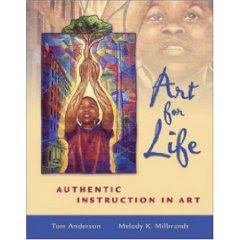- Examining artworks both in progress and after completion and talking with students about those assessments
- Ongoing monitoring of the learner’s progress, which might include examining a portfolio of student’s projects
- Assessing learning in art criticism, art history, and aesthetics through informal journals, in-class written assignments and tests, and contributions to class discussions
- Engaging students in verbal and written expression concerning the meaning they attribute to their work
The Need for Open Objectives and Evaluation Criteria
- Art teachers must value that which is open, indeterminate, and imaginative
- Art teachers must develop educational objectives that value demonstration of interpretation, brainstorming, or the ability to adapt to the unexpected
- Much quality art production occurs during what appears to be nondirectional play
- Encouragement should be given for the irrational and quirky
- Rich educational play should not be confused repeating stereotypical images appropriated from popular culture
The Need for Defined Objectives and Evaluation Criteria
- Needed to meet standards
- Provides clarity for assessing student performance
- Expectancy – the need to inform learners in advance about the objectives of any task they are asked to perform
- Backward design – planning a lesson by first articulating what students will be able to do at the end (this ensures that all lesson-planning builds toward learning outcomes)
Goals, Objectives, and Outcomes
- Standards-based art instruction – when state or local systems set broad goals (i.e. NC Standard Course of Study)
- Teachers must use standards to create objectives
- Objectives – clear, identifiable behaviors that a student can demonstrate
- Bloom’s Taxonomy of Educational Objectives – excellent guide for defining clear, meaningful objectives
- Educational objectives can always be employed
Art Objectives and Assessment
- Teachers emphasize objectives that reflect personal values about art and education, teaching style, and the ages and ability levels, and learning styles of students
- Differing ability levels and learning modes requires emphasis on different objectives
- 5 types of art objectives:
-Artistic perception
-Art Criticism
-Aesthetics
-Art history
Objectives and Evaluation of Art Production
- Be specific
- Stay focused – stress only a few objectives per class period
- Encourage depth rather than range – increases personal investment in projects
Objectives and Assessment of Artistic Perception
- Helps students identify elements of beauty and interest in their daily lives
- Sources for perceptual objectives
-Artworks
-Daily life experience outside the classroom
Objectives and Assessment of Art Criticism
- Ensures students use language of art appropriately
- Can be assessed by asking students to identify how art impacts feeling
- Students should be challenged to identify specific visual details
Objectives and Assessment in Aesthetics
- Can best be assessed through class discussion about the nature of art
- Difficult to encapsulate in specific objectives
Objectives and Assessment of Art History Learning
- Can be evaluated by pencil and paper tests or discussions
Reporting Art Progress to Parents
- Helpful to list main goals of program
- Best indication for parents is actual work with teacher comments attached
School Exhibitions as Assessment Tools
- Enlivens school
- Always include an explanation of artistic problem and draw attention to different ways students solved it
Formative and Summative Evaluation
- Summative evaluation-summarizes student's learning and teacher's effectiveness
- Formative evaluation
-usually done at the end of the academic year
-periodically go over students' work to determine if goals are being met
Self-Assessment
- Reflect on your own skills, strengths, and weaknesses as a teacher
- Try using a video camera in the rear of classroom






No comments:
Post a Comment